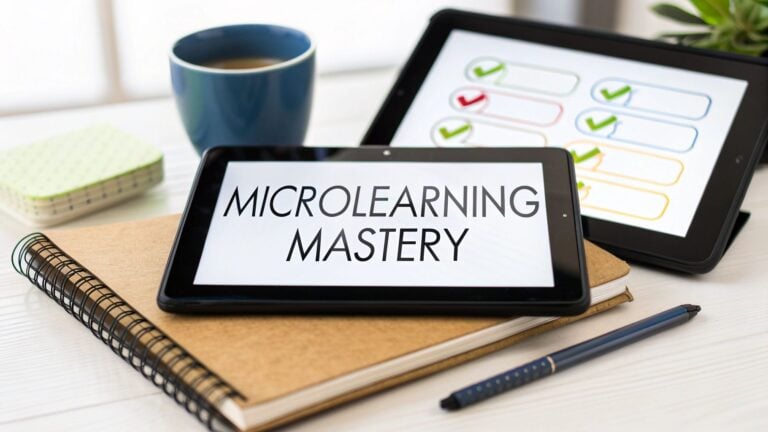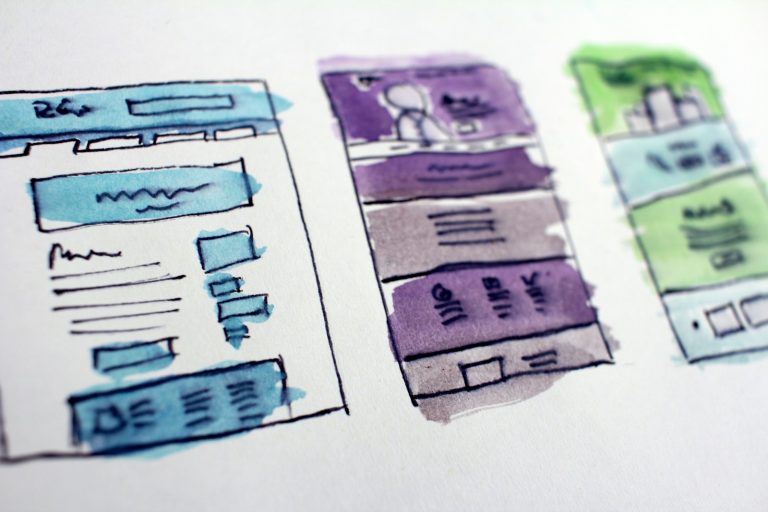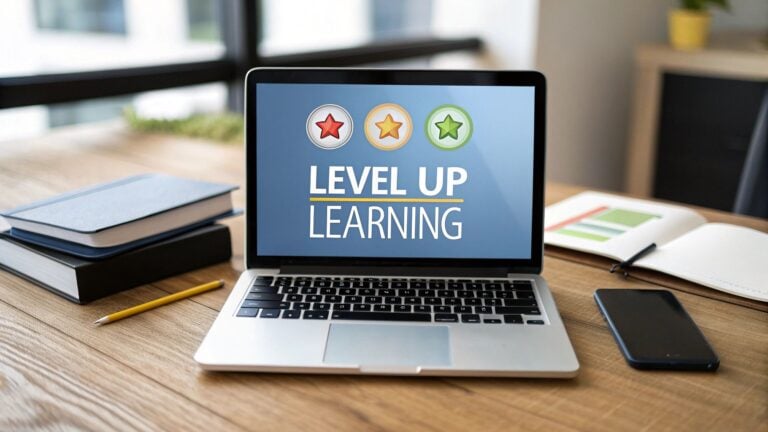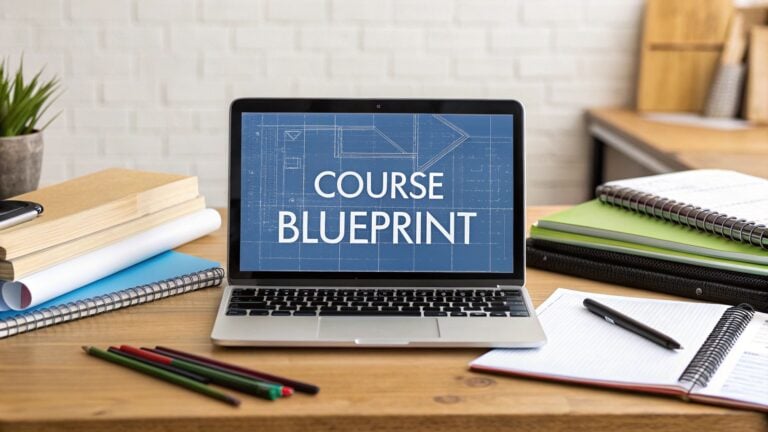Your Free Skills Gap Analysis Template
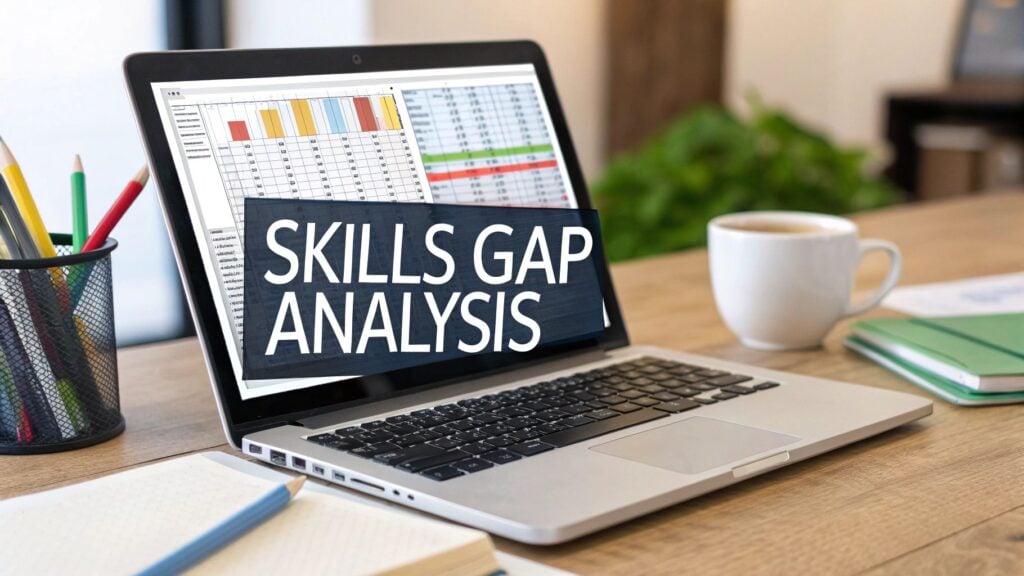
A skills gap analysis template is a structured tool companies use to figure out the difference between the skills their workforce currently has versus the skills they actually need to hit their goals. Think of it as a simple, effective way to pinpoint specific training needs, which makes your development efforts far more targeted and impactful.
Why a Skills Gap Analysis Is a Game Changer
Let’s be honest. Keeping your team’s skills sharp feels like a constant battle. A skills gap analysis is a core business strategy that directly impacts your bottom line.
Ignoring that growing space between the skills you have and the skills you need can lead to real problems down the line. We’re talking about missed project deadlines, frustrated teams, and falling behind competitors who are adapting faster than you are.
Moving Beyond Guesswork
Technology is evolving, and job roles are shifting faster than ever. What worked last year might not be enough to succeed next year. This process removes the guesswork from your training and development budget.
A solid skills gap analysis gives you a clear roadmap. It helps you understand:
- Where your team is strong and where you can lean on internal experts.
- What specific capabilities are missing that could be holding back growth.
- How to prioritize training for the biggest possible impact.
Spotting these gaps early turns your training budget from a hopeful expense into a targeted investment with a clear return. This process helps uncover hidden potential within your team and build a workforce that’s truly ready for the future.
The reality is that most companies are already feeling this pressure. In fact, a staggering 87% of companies report they either already have a skills gap or expect one within a few years.
This isn’t a minor issue. One report estimated that the global skills gap could result in up to $8.5 trillion in unrealized annual revenues by 2030. That’s a massive number tied directly to having the right people with the right skills.
To truly get a handle on how this kind of data can transform your organization, it helps to dig into the broader topic of mastering analytics in HR, which is the foundation for impactful initiatives like this one. This section grounds you in the ‘why’ before we jump into the ‘how,’ making it obvious why this process is so crucial.
How to Build Your Own Analysis Template
Alright, let’s get our hands dirty and build a skills gap analysis template from scratch. Forget fancy or expensive software for now because you don’t need it. A simple, well-structured spreadsheet is an incredibly powerful tool for this, and I’ll walk you through setting one up.
My goal here is to give you something you can use today and tweak for your team’s specific needs. We’ll focus on the essential columns that give you the clearest picture of where your team stands and where you need to guide them. This whole process is about creating clarity.
The Core Components of Your Template
When I’m putting together a new template, I always start with the same five columns. They are the bedrock of any effective analysis, giving you a clear, at-a-glance view of your team’s landscape.
Here’s a breakdown of the key columns and the specific information each one should contain for a powerful analysis.
Core Components of Your Skills Gap Analysis Template
| Template Column | Purpose | Example Entry |
|---|---|---|
| Employee Name | Identifies the person being assessed. | “Jane Doe” |
| Job Role | Clarifies their current title or function. | “Senior Customer Support Specialist” |
| Key Skill | The specific, measurable competency being evaluated. | “Active Listening” |
| Current Proficiency | Rates their current skill level, typically on a 1-5 scale. | “3“ |
| Target Proficiency | The skill level required for them to excel in their role. | “5“ |
This structure makes it easy to see what matters most. The “gap” is simply the difference between the Current and Target proficiency scores. That single number tells you exactly where to focus your development efforts. It’s a straightforward way to visualize who needs support and in what specific areas.
This visual captures that exact moment of discovery, when you finally see where those skill gaps lie.
As the image shows, the first step is always identifying the gaps, which is precisely what our template is designed to do.
Making Skills Measurable
Now, the trickiest part is usually defining that “Key Skill” column. Vague descriptions like ‘good communicator’ are basically useless because you can’t measure them. Instead, you need to break down broad concepts into tangible, observable abilities.
For a customer support role, instead of just ‘communication,’ you might list:
- Active Listening: Can accurately summarize a customer’s issue.
- De-escalation Techniques: Can calm an upset customer effectively.
- Written Clarity: Writes clear, concise support tickets with no jargon.
A well-defined skill is one you can observe and rate consistently. This removes subjectivity from the process and ensures everyone is being evaluated against the same clear standard, which is vital for fairness and accuracy.
Creating a template from zero can still feel a bit daunting. To get a head start, you can lean on a resource like this comprehensive skills gap analysis template and guide from Relevant. It gives you a great starting point you can then tailor to your specific team and business goals. A solid template makes the entire analysis much more manageable.
Pinpointing the Skills That Drive Future Growth
A great template is only half the battle. If you’re not tracking the right skills, you’re just measuring what you did yesterday, instead of preparing for what you need to do tomorrow. I always start by looking at where the company is headed, the big-picture goals, and then work backward to figure out what capabilities my team absolutely must have to get there.
It’s all about being proactive. You have to look at the projects coming down the pipeline, new tech we’re planning to bring in, and the general direction of our industry. Staying ahead of the curve means you’re building skills before you desperately need them.
Looking Beyond the Present
The skills that got you to this point are not the same ones that will propel you forward. To figure out what’s on the horizon, I usually start by asking a few critical questions:
- What are the make-or-break projects on our roadmap for the next 12-18 months?
- Are we rolling out new software or systems that will require a totally new kind of expertise?
- What kinds of roles are our top competitors actively hiring for right now?
The answers to these questions are incredibly revealing. They help separate the “nice-to-have” skills from the mission-critical ones that will genuinely move the needle. For instance, if a major company goal is to slash customer churn, skills like ‘Predictive Customer Behavior Analysis’ suddenly become far more important than general administrative abilities.
This forward-looking approach is essential for survival. The ground is constantly shifting beneath our feet. Research from the World Economic Forum projects that 39% of current core skill sets will be disrupted or obsolete by 2030, thanks to digital transformation. You can read more about the future of job skills on weforum.org.
Translating Goals into Competencies
Once you’ve got those future-focused goals nailed down, the real work begins: breaking them down into specific, measurable abilities. This is where leaning on a competency-based training framework can be a game-changer. It gives you a solid structure for defining what “good” actually looks like for any given skill.
Let’s take a common strategic goal: “Increase product innovation.” That sounds great, but what does it actually mean in terms of skills? You can translate that broad idea into tangible competencies like:
- Creative Thinking: The ability to generate novel, practical solutions to existing problems.
- Rapid Prototyping: The skill to build basic models to test new ideas quickly and cheaply.
- Emerging Tech Literacy: A solid understanding of new technologies relevant to your industry.
When you map your big-picture goals to these concrete skills, your skills gap analysis template transforms. It stops being a simple checklist of current abilities and becomes a powerful, strategic roadmap for real growth.
Accurately Measuring Your Team’s Current Abilities
Alright, this is where the rubber meets the road. It’s often the trickiest part of the whole process, but I’ve got your back. How do you figure out where your team truly stands without just guessing?
The whole point here is to get your hands on clear, unbiased data. We’re trying to paint an accurate picture of your team’s current capabilities. This removes all the guesswork and gives you a solid foundation for whatever action plan comes next.
Over the years, I’ve found that using a combination of methods gives you the most well-rounded view. It’s the best way to prevent any one person’s bias from skewing the results.
Simple and Effective Assessment Methods
You really don’t need complicated software to get started. A few straightforward approaches will give you everything you need to start populating that skills gap analysis template.
Here are a few methods I constantly rely on:
- Self-Assessments: Just ask your team members to rate their own skills. This is a fantastic starting point, but you absolutely must provide crystal-clear definitions for each skill so everyone is working from the same playbook.
- Manager Evaluations: Next, have direct managers rate their team members on that exact same set of skills. This provides a crucial second perspective and helps validate (or challenge) the self-assessments.
- Performance Data: Don’t forget to look at the hard data. Pull up recent project outcomes or performance reviews. This can offer concrete evidence of a person’s abilities in action, moving you beyond subjective ratings.
For any of this to work, you need a consistent rating scale that everyone understands immediately.
I always use a simple 1-5 scale. It’s easy to grasp and works across different roles and skills. For example: 1 = No Experience, 3 = Working Proficiency, and 5 = Expert. This clarity is non-negotiable if you want accurate data.
By combining these different inputs, you can triangulate a much more accurate picture of each person’s skill level. It helps you see where perceptions align and where there might be a disconnect.
Getting a handle on this initial data is also a key part of learning how to measure training effectiveness down the line. This measurement becomes your baseline, the starting point you’ll use to track all future growth.
From Analysis to a Powerful Action Plan
Finding the gaps is really just the beginning. The real magic happens when you turn all that data from your skills gap analysis template into a concrete plan for development. This is where you connect the dots between what you’ve learned and real, measurable improvements for your team.
You’ll want to start by prioritizing. Not all skill gaps are created equal. I always focus first on the ones that have the most direct impact on our big business objectives. A gap in a mission-critical area is always going to be more urgent than a minor “nice-to-have” skill.
Brainstorming Practical Solutions
Once you know your priorities, it’s time to think about solutions. This isn’t a one-size-fits-all situation. The right approach really depends on the skill, the person, and the resources you have to work with.
Here are a few practical options I’ve used successfully:
- Targeted Training: This is great for technical skills. Instead of a general workshop, find a course or an internal expert who can teach the specific ability needed.
- Mentorship Pairings: Connect a team member who is an expert in a certain area with someone who needs to grow. It’s a low-cost, high-impact way to transfer knowledge.
- On-the-Job Coaching: Sometimes, the best way to learn is by doing, with guidance. This involves a manager or peer providing real-time feedback on actual projects.
- Strategic New Hires: If a critical skill is completely missing from the team and you need it fast, sometimes hiring is the smartest move.
The goal is to create personalized development roadmaps. This shows your team that you’re invested in their growth, which is a huge factor in employee satisfaction and retention.
Connecting Analysis to Action
This systematic approach is more important than ever. By 2025, it’s expected that automation and AI will have disrupted 44% of essential skills. A structured plan ensures your upskilling efforts are targeted and agile enough to keep up with these shifts. Discover more insights about preparing for the skills of 2025 at sethmattison.com.
Ultimately, your skills gap analysis should lead directly to a development plan that feels a lot like a training needs assessment template. It’s a clear, actionable guide that bridges the space between where your team is today and where you need them to be tomorrow.
Common Questions About Skills Gap Analysis
People ask me about the finer points of skills gap analysis all the time. Let’s tackle a few of the most common questions to help you get started and sidestep some of the usual pitfalls.
How Often Should We Run This Analysis?
A good rhythm is to conduct a full, in-depth analysis once a year, usually timing it with your annual strategic planning. This ensures your talent development efforts are perfectly aligned with your biggest business goals for the year ahead.
But if you’re in a fast-moving industry or rolling out new tech, a lighter check-in every six months is a really smart move. The whole point is to keep the data relevant and actionable, not to turn it into a bureaucratic chore.
What’s the Biggest Mistake to Avoid?
I see this one all the time: a team does all the hard work of the analysis, creates a beautiful report… and then lets it collect digital dust in a folder somewhere. The follow-through is absolutely everything.
If you don’t build and execute an action plan to close the identified gaps, the entire exercise is a waste of time. The real goal here is development and growth, not just data collection.
Can I Use This for an Individual Employee?
Definitely. In fact, it’s an excellent tool for individual career pathing and performance conversations.
Using the template for a single person helps you co-create a clear, personalized growth plan. It shows them exactly what skills to focus on to move up in their career, taking the guesswork out of professional development.

